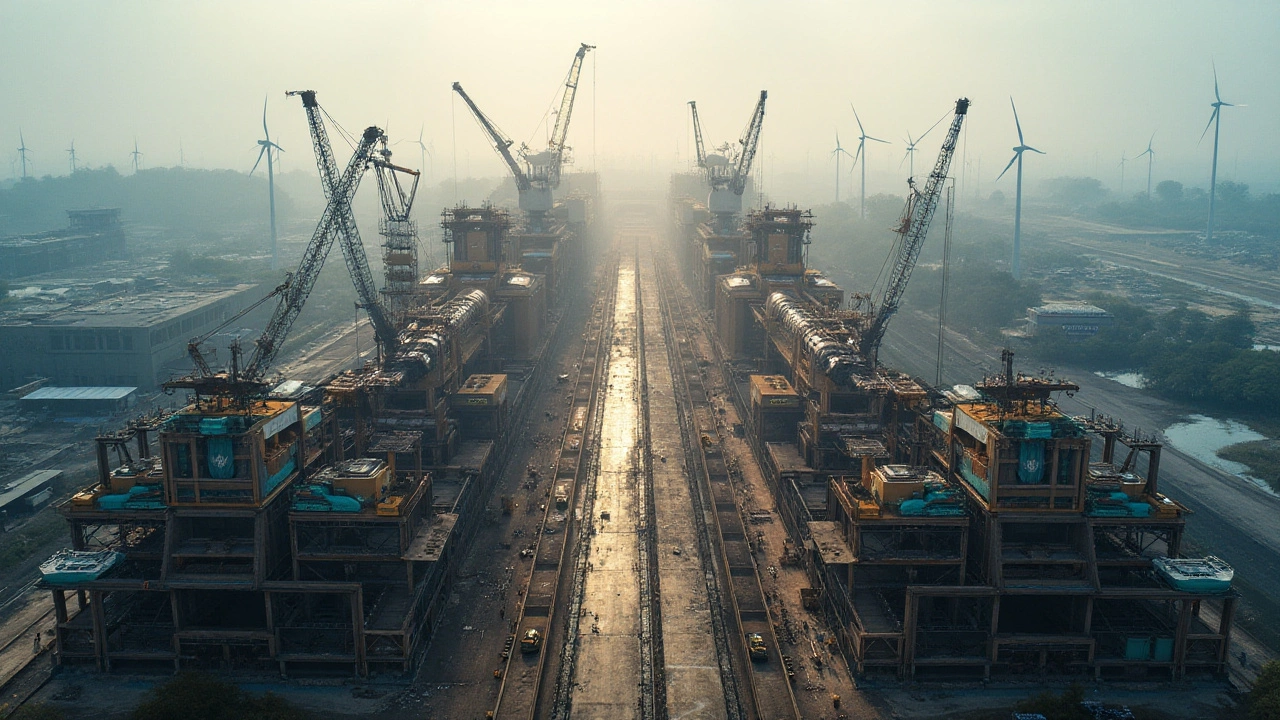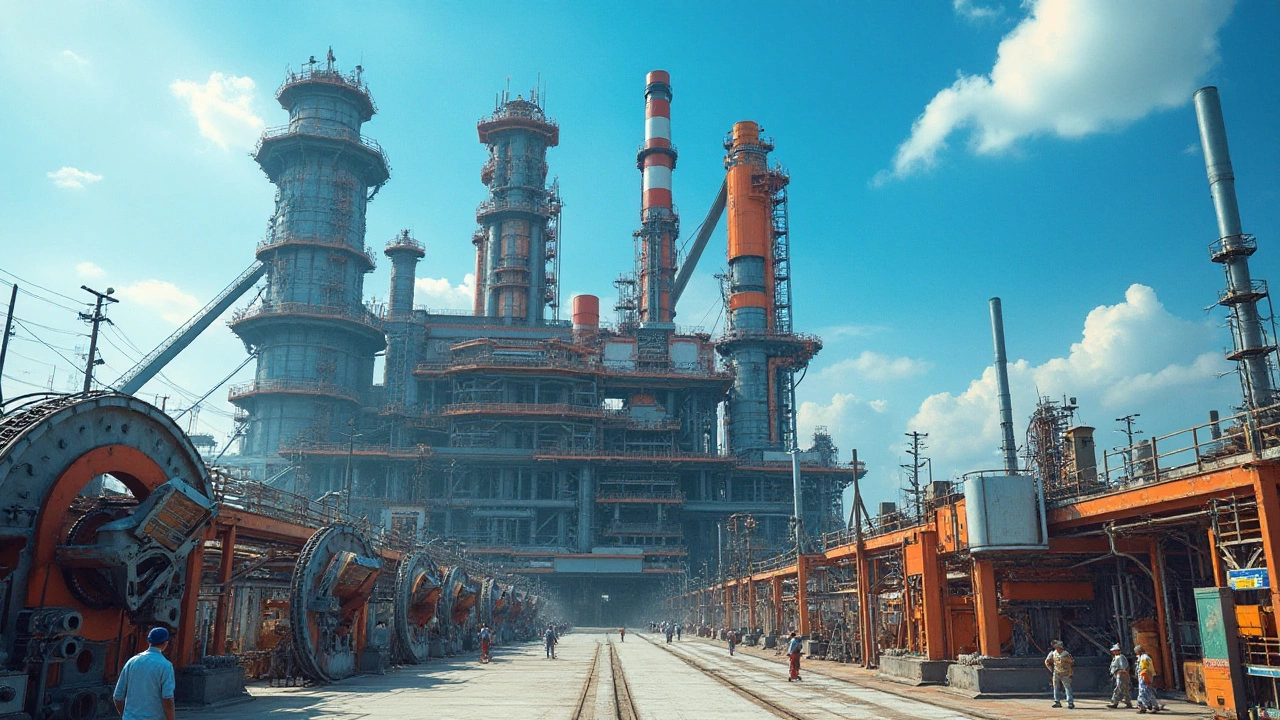In the heart of Asia lies a nation characterized by its ancient heritage and rapid modernization: India. This land of opportunities is not only known for its cultural and historical prominence but also for its significant strides in the field of machinery manufacturing. With a diverse and dynamic industrial sector, India continues to set benchmarks with some of the largest and most complex machines ever crafted.
Walk through any manufacturing plant or industrial exhibition in India, and you're likely to encounter machines that are not just large in size but also monumental in purpose. These machines stand as towering testimonies to the nation's prowess in engineering and innovation. From construction machinery that shapes our skylines to manufacturing tools that power industries, each machine tells a story of meticulous planning, cutting-edge technology, and, above all, unparalleled human ingenuity.
This exploration of India's largest machinery allows us to delve deeper into the heart of Indian industry, unveiling the companies and technologies that drive this sector. As much as it is about what these machines do, it's also about what they represent—a future brimming with potential and a present rich with possibilities. Whether you're an engineering enthusiast, an industry professional, or simply curious, this endeavour promises a fascinating voyage through India's manufacturing might.
- India's Manufacturing Landscape
- The Largest Machinery: A Closer Look
- Noteworthy Machinery Manufacturers
- The Impact on Indian Economy
- Future Prospects and Innovations
India's Manufacturing Landscape
India's journey in the realm of manufacturing has been nothing short of revolutionary. From its modest beginnings in the aftermath of independence, the country has blossomed into a nexus of industrial prowess. The tapestry of this transformation is woven with vibrant threads of innovation, resilience, and ambition. The sheer diversity of products emerging from the manufacturing sector is staggering. Think of textiles, electronics, heavy machinery, and more; each segment crafts its own narrative of success and challenges.
The government has played a pivotal role in shaping this landscape, introducing policies that incentivize domestic production and attract foreign investments. This vision became particularly evident with the 'Make in India' initiative launched in 2014, which serves as a cornerstone of India's industrial strategy. Speaking at a pivotal industry event, an executive from a leading machinery firm noted,
"India's manufacturing sector sits on the cusp of becoming a global leader, driven by our relentless pursuit of excellence and transformation."This remark resonates strongly with the sector's momentum.
Exploring the geographical spread of India's manufacturing capabilities reveals hubs in cities like Pune, Bengaluru, and Chennai. Pune, for instance, is recognized for its dynamic automotive and IT sectors. Meanwhile, Chennai boasts a rich legacy of textile production but has also emerged as a formidable force in the automobile industry. Statistically, India's manufacturing sector contributes approximately 15-17% to the national GDP, consistently demonstrating its fundamental role in the economy. The workforce powering this colossal engine includes millions, reflecting the sector’s significant employment capability.
Innovation continues to be a catalyst in shaping future trajectories, as emerging technologies like AI and IoT find applications in manufacturing processes, enhancing efficiency and precision. Additive manufacturing, commonly known as 3D printing, is also making waves, enabling small companies and large corporations alike to rethink production methods. Considering the human aspect, the skills development programs strive to equip the workforce with contemporary capabilities, ensuring sustained growth. Such advancements indicate a paradigm shift, promising robustness and adaptability in India's machinery sectors.
The Largest Machinery: A Closer Look
In the tapestry of India's industrial achievements, machinery stands as one of its most vibrant threads. When we speak of the largest of these, we do not merely mean in terms of physical size, but the impact and innovation they signify. These machines are colossal in stature, sprawling over several football fields in some instances. Yet, their true measure goes beyond their sheer magnitude.
Take, for instance, the massive draglines used in the coal fields in eastern India. These are among the largest excavation machines in the world. A single dragline can move upwards of 150,000 cubic meters of material per day, demonstrating both the might and precision of Indian engineering. Such machines require an intricate blend of technology, man-power, and visionary design. Across India, in states like Chhattisgarh and Jharkhand, these machines function as the sinews of the country’s industrial backbone, extracting resources vital for energy production. It's fascinating to note that operating these engineering wonders involves over 2,500 components working in harmony.
Another marvel is the giant steel rolling mills that dot the industrial landscape of India. These mills, like the ones in places like Durgapur and Bhilai, spew out millions of tons of quality steel every year. The machinery here does not just forge steel; it forges the aspirations of a nation on the move. Designed to withstand the rigors of extreme temperatures and relentless pressure, they embody endurance and efficiency. These machines may not be visible on the glossy magazines, but their impact is ubiquitous—they are the bedrock of infrastructure, contributing to everything from bridges to high-speed rail networks.
It's crucial to acknowledge the role of innovation in these mega-machines. Several Indian manufacturers are now pioneering green technologies, ensuring that while these machines are powerful, they remain environmentally friendly. A noteworthy development here is the phased incorporation of AI and IoT (Internet of Things) in machine design. It allows for real-time monitoring and predictive maintenance, making these large-scale machines not only efficient but also smart.
The former Minister of Heavy Industries, on a visit to such a manufacturing unit, once remarked, "India's future does not just depend on these machines running; it rests on turning them into harbingers of sustainable growth."
A glimpse into the future reveals an exciting trajectory. Projects in renewable energies, like wind turbines with rotor blades the size of an entire cricket pitch, promise to redefine what 'largest' can imply. These are not just green machines; they are harbingers of a new era—one that melds large-scale machinery with environmental stewardship. India's journey in machinery ingenuity is, thus, not just about shaping the present but molding a sustainable future.

Noteworthy Machinery Manufacturers
India's rise as a global player in the machinery industry is underpinned by several companies that have made significant strides in engineering and manufacturing. These firms stand at the forefront, not just because of their technical prowess, but also due to their relentless pursuit of innovation, quality, and customer satisfaction. Among them is Tata Motors, a name synonymous with automotive excellence and diversification. With a history dating back to 1945, Tata Motors has evolved into a leader in creating commercial vehicles, passenger cars, and construction machinery that resonate with the world.
Another behemoth, Larsen & Toubro, is a powerhouse within the Indian engineering space. Known commonly as L&T, this conglomerate spreads across sectors, delivering expertise in construction, electrical automation, and technology services. Their contribution to the construction equipment sector has been monumental, offering a range of products that are not only durable but also technologically ahead of their time. The name isn't just recognized domestically but is also respected on an international scale, illustrating what it means to craft machinery that leads industry standards.
In the realm of agricultural and rural innovation, Mahindra & Mahindra has carved a path of its own. Starting from humble beginnings, it has grown into a formidable presence in the tractor and farming equipment space. Their machines are a beloved choice among farmers across India, known for their robustness and efficiency. Mahindra & Mahindra's commitment to delivering high-quality machinery that supports sustainable agricultural practices showcases the critical role the company plays in empowering rural development.
In a recent interview published in Industry Week, Ramesh Abhishek, a former Secretary of the Department for Promotion of Industry and Internal Trade, remarked,
"India's machinery manufacturers stand as a shining example of how global ambitions can harmonize with local aspirations. Our industries are the engineers of our nation's future, tailoring global paradigms to India's unique needs."This encapsulates the sentiment and vision shared by these firms as they continue to innovate and inspire.
As the machinery sector continues to evolve, so do the companies that define it. With significant investments in research and development, Indian machinery manufacturers are improving product features and engaging in green innovations that promise a better tomorrow. Their success stories lay not just in units produced or deals closed, but in the relationships forged with communities, embracing the responsibility of setting benchmarks for others to follow. With plans to extend their reach and influence, the journey ahead seems as inspiring as the achievements that lie in their wake.
The Impact on Indian Economy
Imagine walking through vast industrial zones bustling with energy, each dedicated to the creation of machinery that supports countless industries—not just within India but across the globe. The machinery manufacturing sector in India is a cornerstone of the nation's economic prowess. By crafting some of the largest and most efficient machines, India has not only cemented its role in the global marketplace but has also stimulated significant economic growth domestically.
This sector contributes about 8% to India's GDP, making it a vital cog in the economic machinery. Large-scale machinery production has led to the creation of thousands of jobs. It's not just limited to factory jobs; it spans across design, research, quality control, and more, providing diverse employment opportunities for a quickly-growing workforce. The government’s 'Make in India' initiative has been instrumental in driving this growth. By encouraging foreign investment and technological collaboration, the initiative has spearheaded an industrial revolution of sorts, enabling domestic manufacturers to produce complex and large-scale machinery efficiently.
Moreover, machinery manufacturing supports the infrastructure and building industries, vital sectors necessary for a rapidly developing nation. This symbiotic relationship means that as construction projects increase, so does the demand for specialized machinery, creating a ripple effect on the economy. As critical machinery is delivered to these projects, deadlines are met more efficiently, and the economy benefits from an accelerated pace of development.
According to the Reserve Bank of India, "The machinery manufacturing sector directly affects the efficiency of industrial operations, thereby enhancing the country's output." This interconnection underscores the sector's role in bolstering productivity, impacting every facet of the economy.
India’s machinery manufacturers have pushed forward with a keen eye on exports. By developing advanced machinery that meets international standards, Indian manufacturers have found markets across Europe, Africa, and Southeast Asia, bringing valuable foreign exchange into the country. This has not only helped stabilize India's economic position but also elevated its status as a reliable manufacturing hub in the eyes of the world.
Perhaps one of the most promising impacts is the technology transfer that accompanies the machinery production sector. Through partnerships and joint ventures with international firms, there has been a steady inflow of cutting-edge technology and expertise. This has boosted India’s technological capabilities, setting a strong foundation for future innovation in machinery and manufacturing. It's a sector that holds much potential, not just for today, but far into the future.

Future Prospects and Innovations
As India strides into a new era of industrial advancement, the future of machinery manufacturing holds thrilling possibilities. The landscape is evolving at a rapid pace, driven by both technological breakthroughs and the increasing demand for efficient, sustainable solutions. The emphasis on integrating India's rich engineering heritage with modern-day innovations sets a unique stage for the future. Industry experts believe that smart manufacturing is the next frontier, where automation, artificial intelligence, and the Internet of Things (IoT) will play pivotal roles. Recent trends indicate that manufacturers are heavily investing in these technologies to refine processes, enhance productivity, and minimize waste.
A report from the Indian Ministry of Heavy Industries underscores this shift, noting that the sector could contribute substantially to the country's GDP growth within the next decade. It also highlights the potential for job creation, with new roles emerging at the intersection of technology and traditional manufacturing. The integration of these fields is expected to enhance the skills of the workforce, making India a hub for high-tech machinery production. In this context, training and education play critical roles, with vocational programs evolving to keep pace with industry requirements.
"The marriage of technology and manufacturing is not just a trend but a necessity. For India to remain competitive, embracing innovation is key," remarked an industry veteran at a recent conference.
The government is also playing a supportive role in this transformation, offering incentives for research and development in the machinery sector. Initiatives such as 'Make in India' have put Indian manufacturers on the global map, creating a conducive environment for startups and established companies alike. These frameworks not only boost investor confidence but also encourage homegrown solutions that cater to international markets. In the coming years, India is expected to emerge as a leader in sustainable machinery manufacturing, with eco-friendly practices at the forefront.
Predictive Maintenance and Sustainability
A significant trend shaping the industry's future is the use of predictive maintenance powered by AI and machine learning. This approach enables companies to foresee machinery breakdowns and perform maintenance efficiently, reducing downtime and costs. Such capabilities are crucial in a country as diverse as India, where the infrastructure challenges can be daunting. Furthermore, the move towards sustainability is gaining traction, with companies focusing on reducing carbon footprints and adopting renewable energy sources for their operations. The combination of these elements promises a greener, more efficient manufacturing ecosystem.
The machinery sector is expected to witness a robust expansion in the export market as well. Nations across the globe are recognizing India's potential to deliver quality machinery at competitive prices. Such prospects encourage collaborations with international players, which, coupled with domestic talent, empower the sector to innovate continuously. In conclusion, the future of machinery manufacturers in India is a compelling narrative of innovation, growth, and sustainability, promising a bright future that aligns with global standards.

